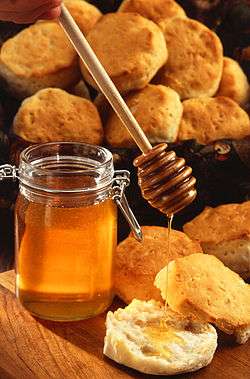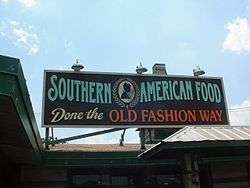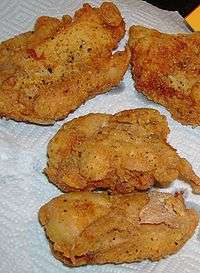Cuisine of the Southern United States
| Part of a series on |
| American cuisine |
|---|
|
Regional cuisines
|
|
Ingredients and foods |
|
Ethnic and cultural |
|
Holidays and festivals |
|

The cuisine of the Southern United States is the historical regional culinary form of states generally south of the Mason–Dixon line dividing Pennsylvania and Delaware from Maryland as well as along the Ohio River, and extending west to southern Missouri, Oklahoma and Texas.
The most notable influences come from African, English, Scottish, Irish, French, and Native American cuisines. Tidewater, Appalachian, Creole, Lowcountry, and Floribbean are examples of types of Southern cuisine. In recent history, elements of Southern cuisine have spread north, having an effect on the development of other types of American cuisine.
Many items such as squash, tomatoes, corn (and its derivatives, including grits), as well as the practice of deep pit barbecuing were inherited from the southeastern American Indian tribes such as the Caddo, Choctaw, and Seminole. Many foods associated with sugar, flour, milk, eggs (many kinds of baking or dairy products such as breads and cheeses) are more associated with Europe. Black-eyed peas, okra, rice, eggplant, benne (sesame) seed, sorghum, and melons, as well as the spices can be attributed to peoples of African origin.
The South's propensity for a full breakfast (as opposed to a Continental one with a simple bread item and drink) is derived from the English fry up, although it was altered substantially. Much of Creole cuisine is based on France, West Africa and Spain to a lesser extent. Floribbean is more Spanish-based with obvious Caribbean influences, while Tex-Mex has considerable Mexican and Native American influences.
Traditional Southern dishes

A traditional Southern meal is pan-fried chicken, field peas (such as purple hull peas), greens (such as collard greens, mustard greens, turnip greens, or poke salad), mashed potatoes, cornbread or corn pone, sweet tea, and a dessert that is usually a pie (sweet potato, chess, shoofly, pecan, and peach are traditional southern pies), or a cobbler (peach, or blackberry).
Some other foods and beverages commonly associated with the South are grits, country ham, hushpuppies, beignets, Southern styles of succotash, mint juleps, chicken fried steak, buttermilk biscuits (may be served with butter, jelly, fruit preserves, honey, gravy or sorghum molasses), pimento cheese, boiled or baked sweet potatoes, pit barbecue (especially ribs), fried catfish, fried green tomatoes, bread pudding, okra (fried, steamed, stewed, sauteed, or pickled), butter beans, pinto beans, and black-eyed peas.
Fried chicken is among the region's best-known exports. It is believed that the Scots, and later Scottish immigrants to many southern states had a tradition of deep frying chicken in fat, unlike their English counterparts who baked or boiled chicken.[3][4][5] Pork is an integral part of the cuisine. Virginia ham is one example. Stuffed ham is served in Southern Maryland.[6] A traditional holiday get-together featuring whole hog barbecue is known in Virginia and the Carolinas as a "pig pickin'". Green beans are often flavored with bacon and salt pork, biscuits served with ham often accompany breakfast, and ham with red-eye gravy or country gravy is a common dinner dish.
It is not uncommon for a traditional southern meal to consist of only vegetables with no meat dish at all, although meat or meat products are often used in the cooking process. "Beans and Greens," which consists of either white or brown beans alongside a "mess" of greens has always been popular in most parts of the South. Turnip greens are generally prepared mixed with diced turnips and a piece of fatback. Another Southern staple is "Beans and Cornbread," consisting of pinto beans, stewed with ham or bacon, and cornbread. This is served sometimes with collards, or turnips.
Southern cuisine for the masses

A niche market for Southern food along with American comfort food has proven profitable for chains, which have extended their market across the country, instead of staying solely in the South. Other Southern chains specialize in this type of cuisine, but have decided mainly to stay in the South. Pit barbecue is popular all over the American South; many rural places even sport several locally run locations, although this is rare in most other parts of the country. There are many individual family style restaurants based on the cuisine of the American South. Despite the down-home image of many Southern-influenced restaurants, some are more upscale. There are several chains with mass-produced items of Southern cuisine on their menus, such as Cracker Barrel, Kentucky Fried Chicken, Waffle House, Bojangles' Famous Chicken 'n Biscuits, Chicken Express, Church's Chicken, Mrs. Winner's, Sonny's, Tudor's Biscuit World and Popeye's.
Southern cuisine by region
Southern cuisine varies widely by region:
- In Southern Louisiana, there is Creole cuisine. Louisiana is also a large supplier of hot sauces with its peppers, as well as being the largest supplier of crawfish in the country.[7]
- Rice was historically an important crop in the coastal areas of South Carolina, leading to local specialties like "Hoppin' John" (a mixture of rice and Black-eyed peas flavored with salt pork) and Charleston Red Rice.
- Barbecue has many regional variations in the South. Barbecue sauce, if used, also varies by location.
- Arkansas produces Riceland rice and sweet corn, both of which are staples of the cuisine of Southeastern Arkansas.
- Virginia produces Smithfield ham.[8]
Oklahoma has a reputation for many grain- and bean-based dishes, such as "cornbread and beans" or the breakfast dish biscuits and gravy. Mississippi specializes in farm-raised catfish, found in traditional "fish houses" throughout the state. Arkansas is the top rice-producing state in the nation, and is also noted for catfish, pork barbecue at restaurants, and chicken. Tennessee is known for its country ham and Memphis, TN is known for several famous barbecue restaurants and a major barbecue cooking competition held in May. Maryland is known for its blue and soft-shell crabs, and Smith Island Cake. Florida is home of the Key lime pie and swamp cabbage. Orange juice is the well-known beverage of the state. Georgia is known for its peaches, pecans, peanuts and Vidalia onions.
The Appalachian areas have ramps (onions and their relatives) and berries aplenty. Kentucky is famous for Burgoo and beer cheese. Texas specializes in barbecue and chili as well as a regional variation of Mexican food unique to Texas called Tex-Mex. Brunswick stew, which originated in the town of Brunswick, Georgia, is also popular. Generally speaking, many parts of the Upper South specialize more in pork, sorghum, and whiskey, while the low country coastal areas are known for seafood (shrimp and crabs), rice, and grits. The western parts of the South like Texas and Oklahoma are more beef-inclined and the eastern parts lean more towards pork.
Louisiana Creole cuisine

Southern Louisiana developed significant culinary traditions. Creole cuisine also had access to many native coastal animals, such as crawfish (commonly called crayfish outside the region), crab, oysters, shrimp, and fish. These seafoods were incorporated into their diets and are still seen today in the various dishes of the region. Fruits such as figs, plums and grapes are also grown in the region. Additionally, pecans and peanuts are native to the region, providing an alternative protein source.
.jpg)
Lowcountry cuisine
The Lowcountry region of the coastal Carolinas, Virginia, and Georgia shares many of the same food resources as the Upper Gulf Coast—fish, shrimp, oysters, rice, and okra. It also displays some similarities to Creole and Cajun cuisines.
Appalachian cuisine
Travel distances, conditions, and poor roads limited most early settlements to only foods that could be produced locally. For farmers, pigs and chickens were the primary source of meat, with many farmers maintaining their own smokehouses to produce a variety of hams, bacons, and sausages. Seafood, beyond the occasionally locally caught fish (pan-fried catfish is much loved) and crawfish, were unavailable until modern times. However, Appalachia did offer a wide variety of wild game, with venison and squirrel particularly common, thus helping compensate for distance from major cities and transportation networks. As wheat flour and baking powder/baking soda became available in the late 19th century, buttermilk biscuits became popular. Salt was primarily available from Saltville, Virginia, but until black pepper appeared, few other seasonings were used. Women were often herbalists, and used local plants like spicebush in seasoning. Chicory, which can be grown or gathered locally, was historically used as a coffee substitute during times when coffee was not freely available, such as during the American Civil War and World War II. The two primary sweeteners in Appalachia were sorghum and honey—the sugar cane molasses of the lowland South never was a dominant sweetener.
Today, a breakfast of buttermilk biscuits and sausage gravy is common throughout the region, as well as places Appalachian people have migrated. Pork drippings from frying sausage, bacon, and other types of pan-fried pork are typically collected and used for making gravy and in greasing cast-iron cookware. Chicken and dumplings and fried chicken remain much-loved dishes. Cornbread, corn pone, hominy grits, mush, cornbread pudding and hominy stew are very common foods, as corn is the primary grain grown in the Appalachian hills and mountains. Fruits that tend to be more popular in this area are apple, pears, and berries. Sweetened fried apples remain a common side-dish. Maple syrup and maple sugar are occasionally made in the higher elevations where sugar maple grows. Wild morel mushrooms and ramps (similar to scallions and leeks) are often collected. In Appalachia one may find festivals dedicated to the ramp plant. Home canning is a strong tradition here as well. Dried pinto beans are a major staple food during the winter months, used to make the ubiquitous ham-flavored bean soup usually called soup beans. Canning included green beans (half-runners, snaps) as well as shelly beans (green beans that were more mature and had ripe beans along with the green husks). Kieffer pears and apple varieties are used to make pear butter and apple butter. Also popular are bread and butter pickles, fried mustard greens with vinegar, pickled beets, chow-chow (commonly called "chow") and a relish called corn ketchup. Tomatoes are canned in large numbers, and fried green tomatoes are common. Along with sausage gravy, tomato gravy, a roux thinned with tomatoes, is very popular. A variety of wild fruits like pawpaws, wild blackberries, and persimmons are also commonly available in Appalachia.
Crow blackbirds, dove, ducks and other game fowl are consumed in the United States. Rat stew is consumed in American cuisine in the state of West Virginia.[12][13] West Virginians also eat roadkill.[14] In the American state of Arkansas, beaver tail stew is consumed in Cotton town.[12] Squirrel, raccoon, possum, bear, muskrat, chipmunk, skunk, opossum, groundhog, pheasant, armadillo and rabbit are also consumed in the Appalachian region of the United States.
See also
- Barbecue
- Cuisine of the Southwestern United States
- Cuisine of the United States
- Liberian cuisine
- Soul food
- Southern Food and Beverage Museum
- Tex-Mex cuisine
Notes
- ↑ David Williamson. "UNC-CH surveys reveal where the 'real' South lies". Retrieved 22 February 2007.
- ↑ http://www.pfly.net/misc/GeographicMorphology.jpg
- ↑ "Southern fried". Enquirer.com. Retrieved 2009-06-20.
- ↑ "Southern favorites". Southernliving.com. Retrieved 2016-01-05.
- ↑ Lynne Olver. "history notes-meat". The Food Timeline. Retrieved 2009-06-20.
- ↑ Gray, Mary Z. (5 December 1982). "Stuffed Ham With A Kick". The New York Times. Retrieved 31 July 2012.
- ↑ Farmed Crawfish vs Wild Crawfish
- ↑ LIS > Code of Virginia > 3.2-5419
- ↑ Brasseaux, Ryan A.; Brasseaux, Carl A. (1 February 2014). "Jambalaya". In Edge, John T. The New Encyclopedia of Southern Culture: Volume 7: Foodways. University of North Carolina Press. p. 188. ISBN 978-1-4696-1652-0.
- ↑ Anderson, E. N. (7 February 2014). Everyone Eats: Understanding Food and Culture, Second Edition. NYU Press. p. 106. ISBN 978-0-8147-8916-2.
- ↑ Davidson, Alan (11 August 2014). "Jollof rice". The Oxford Companion to Food. Oxford University Press. p. 434. ISBN 978-0-19-967733-7.
- 1 2 http://news.nationalgeographic.com/2015/12/151220-american-food-cuisine-local-state-ngbooktalk/
- ↑ http://munchies.vice.com/articles/americas-most-beloved-regional-dishes-have-dark-and-fascinating-histories
- ↑ http://munchies.vice.com/articles/there-was-no-roadkill-on-the-menu-at-the-west-virginia-roadkill-festival
References
- Bowen, Carl. Southern-Recipes. 2010. ISBN 978-1-4563-4479-5.
- Domine, David. 111 Fabulous Food Finds: Best Bites in the Bluegrass. McClanahan Publishing House, 2011. ISBN 978-1-934898-12-3.
- Domine, David. Adventures in New Kentucky Cooking with the Bluegrass Peasant. McClanahan Publishing House, 2007. ISBN 0-913383-97-X.
- Domine, David. Splash of Bourbon, Kentucky's Spirit. McClanahan Publishing House, 2010. ISBN 978-1-934898-06-2
- Harris, Jessica. On the Side: More than 100 Recipes for the Sides, Salads, and Condiments That Make the Meal. Simon & Schuster, 2004. ISBN 0-7432-4917-8.
- The Junior League of Charleston. Charleston Receipts. Wimmer Brothers, 1950. ISBN 0-9607854-5-0.
- Lewis, Edna and Peacock, Scott. The Gift of Southern Cooking: Recipes and Revelations from Two Great American Cook. Knopf, 2003. ISBN 0-375-40035-4.
- Neal, Bill. Bill Neal's Southern Cooking. University of North Carolina Press, 1989. ISBN 0-8078-4255-9.
- Neal, Bill. Biscuits, Spoonbread, and Sweet Potato Pie. University of North Carolina Press, 2003. ISBN 0-8078-5474-3.
- Neal, Bill. Good Old Grits Cookbook. Workman Publishing Company, 1991. ISBN 0-89480-865-6.
- Snow, Constance. Gulf Coast Kitchens. Clarkson Potter/Publishers, 2003. ISBN 0-609-61011-2.
- Sohn, Mark F. Appalachian Home Cooking History, Culture, & Recipes Lexington: University Press of Kentucky. 2005. ISBN 0-8131-9153-X
- Taylor, John. Hoppin' John's Lowcountry Cooking. 1992. ISBN 0-553-08231-0.
- Walter, Eugene. American Cooking: Southern Style. New York: Time Life Books, 1971.
Further reading
- Edge, John T., ed. (2007). The New Encyclopedia of Southern Culture Volume 7: Foodways. University of North Carolina Press. ISBN 978-0-8078-5840-0.
- Ferris, Marcie Cohen (2014). The Edible South: The Power of Food and the Making of an American Region. Chapel Hill, NC: University of North Carolina Press.
External links
- "Talk with your mouth full – what is Southern food?" CNN. December 2, 2010.
- Southern Barbecue Primer
- Southern Foodways Alliance
- Southern Food & Beverage Museum
- Southern Recipes and Cooking
| ||||||||||||||||||
| ||||||||||||||||||||||

